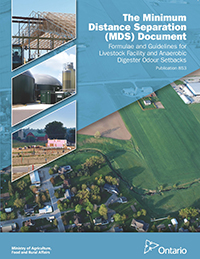Minimum Distance Separation (MDS) formulae
Learn about what the Minimum Distance Separation (MDS) formulae and guidelines are and what you need to know to complete a calculation for an MDS setback.
In Ontario's rural and prime agricultural areas, the Provincial Policy Statement, 2024, and other provincial land use plans require that new land uses, including the creation of lots and new or expanding livestock facilities, comply with the Minimum Distance Separation (MDS) formulae and guidelines.
The MDS formulae and guidelines are land use planning tools that determine setback distances between livestock barns, manure storages or anaerobic digesters and surrounding land uses, with the objective of minimizing land use conflicts and nuisance complaints related to odour. Demonstrating that an MDS setback can be met, may be required before a land use planning approval or building permit can be issued.
MDS is comprised of two separate, but related, formulae that act reciprocally to help site either new development or new/expanding livestock facilities:
- MDS I setbacks are determined between proposed new development and existing livestock barns, manure storages and/or anaerobic digesters.
- MDS II setbacks are determined between proposed new or altered livestock facilities and/or anaerobic digesters and existing or approved development, lot lines and road allowances.
The Minimum Distance Separation (MDS) document
The MDS formulae, definitions, factors, implementation guidelines, calculation forms, explanatory schematics and additional training information are contained in Publication 853, "The Minimum Distance Separation (MDS) Document: Formulae and Guidelines for Livestock Facility and Anaerobic Digester Odour Setbacks." This document came into effect on March 1, 2017 and replaces all prior versions of the MDS formulae and guidelines.

You can download a digital PDF version of the Minimum Distance Separation (MDS) Document, Publication 853 here or order a free hard copy through ServiceOntario.
Online: ontario.ca/publications
By phone: Monday to Friday, 8:30 AM to 5:00 PM
416-326-5300
416-325-3408 (TTY)
1-800-668-9938 toll-free across Canada
1-800-268-7095 TTY toll-free across Ontario
AgriSuite software
The province has developed AgriSuite software which contains digital tools that allow users to quickly calculate MDS setbacks between proposed:
- new development and existing livestock barns, manure storages and/or anaerobic digesters (MDS I)
- new or altered livestock facilities and/or anaerobic digesters and existing or approved development, lot lines and road allowances (MDS II)
Calculated setback distances vary according to five factors and, depending on the type of calculation being done (MDS I or MDS II), users will need to input information into AgriSuite, such as:
- the type of livestock housed
- the potential number of livestock housed
- the percentage increase in the size of the operation
- the type of manure system and storage
- the type of encroaching land use
- the size of the lot on which the livestock facility is located, etc.
This information is used to populate the various factors in the corresponding MDS formula. More details, including suggested sources to obtain this information, are referenced in the MDS Document, Publication 853. It is recommended that users consult this document when utilizing the MDS tools in AgriSuite. Visit the AgriSuite web page to access the MDS digital tools.
Role of municipalities
Municipalities are responsible for ensuring that MDS setbacks are met when reviewing land use planning applications (for example, lot creation applications) or building permits. Contact your local municipality for questions regarding the implementation of the MDS in your area if you are proposing to construct a new livestock facility, anaerobic digester or other building, or you are pursuing a land use planning application, such as an official plan amendment, zoning by-law amendment, or an application to create a new lot.
While municipalities are responsible for ensuring that the requirements of MDS are met when reviewing land use planning applications or building permits, municipalities may implement this requirement in different ways. Some municipalities will ask an applicant to provide the information necessary for the municipality to complete the calculation of MDS. In other cases, a municipality may request that an applicant provide a calculated MDS setback. In this instance, it may be helpful for an applicant to hire a land use planning consultant or a nutrient management consultant to undertake the MDS calculation. In all cases, a municipality must review any MDS calculations to ensure they are accurate.
For more information
If you are a farmer or landowner, your first point of contact for inquires related to MDS should be your local municipality. Municipalities are responsible for the implementation of MDS as part of their review and approval of building permit applications and applications under the Planning Act. If necessary, municipalities are encouraged to update local zoning by-laws and official plans.
If you work for a municipality, a land use planning consulting firm or a nutrient management consulting firm and have questions related to the MDS and the calculator tools contained in AgriSuite, or other agricultural land use policies, please contact the Agricultural Information Contact Centre at